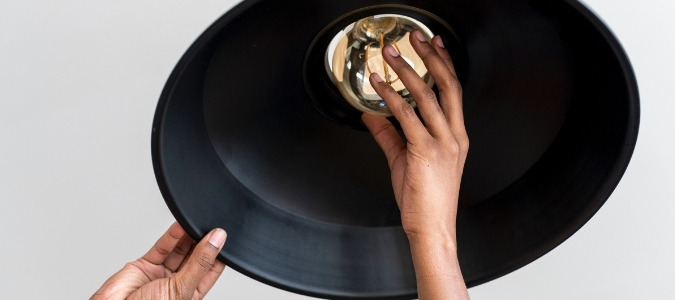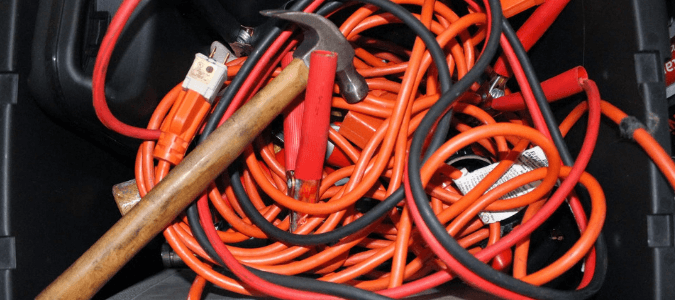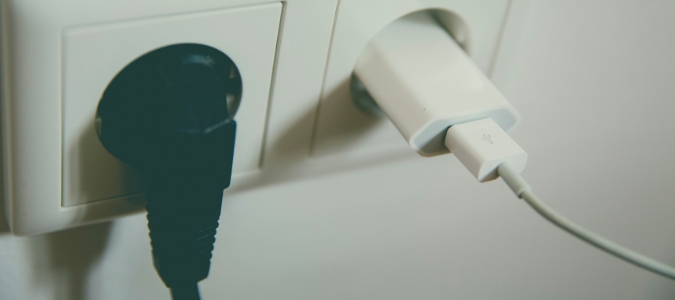
You’ve dealt with electricity in your home before. We all have. Say the power goes out and you need to flip the breakers. A much more common experience is the countless times you’ve had to change a light bulb. No big deal.
So, when you decided to put ceiling fans around your house, you opted to do it yourself. After all, you’re a smart person. How hard could it be?
Most homeowners soon discover that dealing with electrical tasks around the house isn’t as straightforward as we’d imagine. Using the example of installing ceiling fans, perhaps you flipped off the breakers in the places where you were putting the fans. You got the right tools. You hung the fans up, one by one. Boom. Done. Except that when you flipped the power back on, two of them didn’t work. Sigh.
So, you went back and forth, turning off the power, working on the fans, then turning the breakers back on. The fans just weren’t working, but you refused to give up.
Then it happened.
You probably just got confused with all the back and forth. Forgot which breaker was on and which was off, because the next time you started messing with the fan in the living room, you got a little surprise: a mild electric shock. Thankfully, it wasn’t anything more serious, but it woke you up about electrical safety. After that experience, most of us would want to make sure nothing like that happened ever again.
As a society, we tend to take electrical power for granted. It’s just something that’s always there in the background. It keeps our lives running.
That said, most of us don’t really know a whole lot about the electricity in our homes. We don’t think about how complicated it is and how dangerous. When you really think about it, a brush with electricity could lead to devastating consequences.
Electrical problems are among the leading causes of home fires in the United States alone. Reports from the U.S. Fire Administration indicate these issues account for over 67,000 fires and over 450 deaths each year in America. These numbers don’t even factor in the more than $800 million in property loses annually linked to electrical fires and other related issues.
Electrical fires are often odorless, rarely giving off any smoke. Most of the time, they occur insidiously, when faulty electrical wiring heats up and begins to smolder gradually. Full ignition can take months. Worse, electrical fires are tricky and quite difficult to put out. If unchecked, they can take down an entire house in minutes.
So, if you have decided it’s time to get serious about electrical safety—good call. We aim to help with this article by teaching you how to adopt smart electricity safety practices to make your home as safe as possible. Let’s start with some things to watch out for.
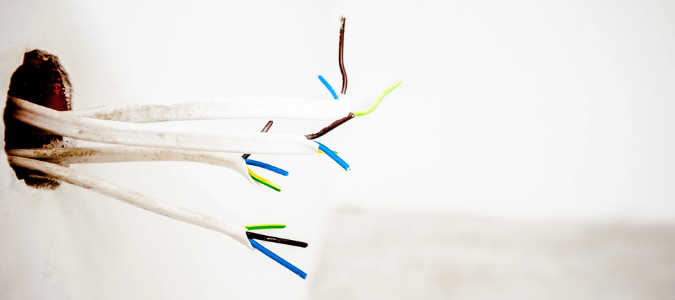
Common Electrical Problems At Homes
Almost every home has electrical hazards, and it’s not really possible to prevent all possible electrical accidents. Nevertheless, many homeowners are unaware of, or simply choose to ignore, some of these common electrical hazards that can be at least minimized.
Unprotected Outlets
Electrical outlets without any protective covering over the holes of the socket pose a significant risk, particularly to young children. Curious children may stick metal objects or even their fingers into exposed socket holes. The outcome of doing so could be devastating and may include electrocution, burns or shock.
Poor Wiring
When people try to go the DIY route without adequate technical knowledge about electricity, they may end up increasing the risk of electric current surges, arc faults and electric fires. Some of the most familiar wiring problems at home include:
- Cracked wire insulation
- Loose connections
- Pinched wires
- Frayed cords
- Overheating wires
- Damaged appliances
Outdated Wiring
Rewiring your home electrical system may be something you should consider if your wires are outdated and constantly giving you trouble. In fact, the National Fire Prevention Association warns that outdated wiring is a common cause of residential fires in America. If electrical wiring is outdated, it may cause sparks that fly out and ignite a fire.
In the 1960s and ‘70s, aluminum branch circuits were used for most homes. Today, the vast majority of circuits have copper wires. Unlike copper, aluminum is brittle, soft and prone to oxidation. This makes aluminum wires more likely to overheat and produce electrical arcing at their termination points, which means that with aluminum branching circuits, every switch, plug and junction box is a potential electrical hazard.
Old Electric Panels
Today’s electric consumption is much greater than that of three to four decades ago. Old panels often have limited space, which impedes a home owner’s efforts to add more circuits. They also have old fuse panels that can’t support the electric consumption of modern home appliances.
Ever asked yourself the question: Should I upgrade my electrical panel? Well, if your house has an electric panel that only offers a 60-amp service, you need to upgrade it. Most homes today require at least a 200-amp panel to cater to modern household electric needs.
Loose Electric Connections
Lose connections may occur at the outlet or within the circuit breaker. When they occur, they result in arcing sparks. The spark may start small flares and fires that can potentially set the entire house ablaze. Loose connections may be evidenced by blackening around outlet plugs that may or may not be accompanied by a burning smell.
Potential Light Bulb Hazards
Light bulbs are, by and large, harmless. Nevertheless, they may become a fire hazard when:
- Exposed to flammable material. This may occur when upholstery (e.g. bedsheet and drapes) is left in contact with a lit, hot bulb.
- Very high voltage bulbs are used. This phenomenon, also known as “over-lamping,” produces more heat than bulb fixtures can sustain. If unchecked, the heat may eventually melt the wire insulation and cause arc-sparking.
- Electricity is left on. Replacing a light bulb before switching off the electricity may put you at risk for electric shock.
Electricity And Water
Water plus electricity is a recipe for disaster. Period. Never use electrical gadgets or appliances near water.
Electricity Safety Tips At Home
Use the following guidelines to improve general electrical safety around your house:
- Child safety wall plates should be installed to cover socket holes when electrical outlets are not in use.
- No light bulb should exceed the wattage rating of its fixture. If the fixture doesn’t show its wattage rating, use a 60-watt (or lower) bulb.
- If you think you may have an electrical problem, call in a licensed electrician to assess your home’s electrical safety. A professional electrical inspector should be called in to inspect a house if:
- It’s more than 30 years old (old houses should be inspected annually);
- You experience unexplained light flickering or dimming;
- There are spliced and frayed wires;
- Outlet sparks are seen;
- Burn marks are seen on or around the outlet;
- The outlet feels unusually hot;
- Buzzing noise is heard in or near an outlet;
- A smell of burnt plastic is felt or
- Circuit breakers trip often.
- Do not use plugged-in electric gadgets in water, near water or with wet hands.
- Do not use wet appliances. If an electric gadget gets wet, do not touch it or unplug it. First, switch the electricity off at the circuit breaker panel, then unplug it. Wait for it to dry out completely before using it again.
- Electric fires must never be put out with water; a fire extinguisher should be used.
- GFCIs (Ground Fault Circuit Interrupters) should be installed in places where electricity is used in the vicinity of water receptacles such as sinks, bathrooms and laundry rooms, among others. GFCIs prevent electrical accidents by shutting the power off when an electric current is detected to be flowing through the water.
- Upgrade the electrical wiring in your home to the latest acceptable standards if you have an older home or if your electrical needs outstrip your current demands.
What To Know About Extension Cord Safety
The use of extension cords at home is safe so long it is done following the manufacturer’s recommendations. Nevertheless, homeowners often use extension cords irresponsibly, thereby exposing their households to untold electrical risk.
How do people do this?
Extension cords have specific electrical capacities and ratings. Each appliance should, therefore, match the electrical rating of the extension cord into which it is plugged. Using devices with higher electrical demands than the cord’s capacity may result in overheating – and possibly electric fires.
Additionally, some folks try to hide extension cords under rugs, carpets, furniture, and other items. Unfortunately, this hinders proper dissipation of heat from the cable. These cords should always be uncovered to avoid overheating and possible electrical fire.
Moreover, when an extension cord is hidden under a carpet where there’s significant human traffic, its insulation gradually wears out and breaks down. This increases the risk of electric shock and fire.
Finally, some households overuse power cords. In addition to installing too many cables in a single outlet, they often bundle them together. This greatly increases the risk of overheating and electrical fire outbreak.
Each outlet should support a single extension cord. If that doesn’t satisfy your electrical needs, bite the bullet and get an electrical professional to install extra outlets in your house—it’s much safer.
Remember that power cords are a temporary solution. The only lasting solution to your power consumption needs should be permanent wiring installed by a professional.
Additional Extension Cord Dos And Don’ts
- Do keep power cords away from water.
- Do insert cord plugs fully into the power outlet.
- Do maintain some slack in power cords to prevent undue tension to the electrical terminals on either end of the cable.
- Do place safety covers on extension cord receptacles that are not in use.
- Do not plug one power cord into another.
- Do not force a power cord plug into an outlet if it doesn’t fit.
- Do not modify or move the metal parts of a power cord.
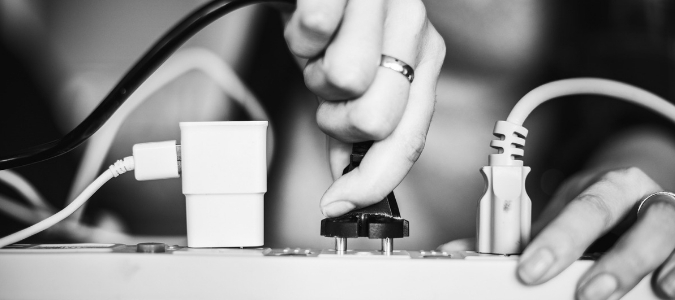 Best Practices For Power Strip Safety
Best Practices For Power Strip Safety
Many homeowners overload power outlet strips (otherwise known as power bars, plug strips, surge protectors, temporary power taps and so on). This is a horrible idea, because overloading causes the overall power consumption to exceed the power strip’s capacity. The end result of overloading is an elevated risk of overheating and subsequent electrical fire.
Overloading may also occur when a high current device (e.g. a space heater, toaster, oven, toaster, etc.) is plugged into a low-current power strip. Doing this culminates in tripped circuit breakers, overheating and even electrical fires.
Best practices when using power strips include:
- Using only those power trips that bear the mark of a nationally-recognized laboratory, such as UL or CSA.
- Not “daisy chaining” multiple power strips together.
- Not exceeding the load capacity of a power strip.
- Not plugging high-current gadgets such a furnace, space heater or microwave into power strips. Such equipment should be plugged into a wall outlet.
- Not using a power strip if it’s damaged or if it shows sign of overheating.
Avoid Electrical Dangers By Using ABC
The DIY culture has fooled many people into believing that you can fix anything as long as you watch a YouTube video. While this approach may work for some projects around the house, electrical tasks can be very dangerous. Botched electrical works may kill you, cause injury or disability, destroy property and put those around you in serious risk of harm. The wiring, outlets, power cords, power strips and circuitry in your home will only operate safely and reliably if they’re checked and maintained routinely. If you have an electrical issue to deal with around your home, the safest thing you can do is get in touch with the licensed electricians at ABC Home & Commercial. With the help of our experts, you can safely and quickly deal with those electrical projects on your to do list.
